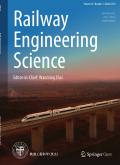电气化铁路的牵引动力系统:发展、现状和未来趋势
IF 5.4
1区 工程技术
Q2 TRANSPORTATION SCIENCE & TECHNOLOGY
引用次数: 0
摘要
牵引动力系统在电气化铁路的运行中起着至关重要的作用。传统铁路tps向新型结构的转变,既是推动电气化铁路向高效、弹性方向发展的趋势,也是实现碳中和目标的必然要求。本文在对传统交流和直流模式供电结构进行梳理的基础上,首先回顾了现有tps供电灵活性弱、能效低等特点。并详细介绍了未来电气化铁路各种输配电系统的供电结构,满足更远距离、低碳、高效、高可靠、高质量的供电要求。同时,从技术和经济两个方面探讨了不同牵引方式的应用前景。最后,介绍了混合系统电气化铁路和无接触网牵引供电技术的研究进展,推测了tps未来的发展趋势和挑战,并预测tps将以连续供电模式为基础,利用电力电子设备和智能信息技术,构建可再生能源的铁路综合能源系统。本文章由计算机程序翻译,如有差异,请以英文原文为准。

Traction power systems for electrified railways: evolution, state of the art, and future trends
Abstract Traction power systems (TPSs) play a vital role in the operation of electrified railways. The transformation of conventional railway TPSs to novel structures is not only a trend to promote the development of electrified railways toward high-efficiency and resilience but also an inevitable requirement to achieve carbon neutrality target. On the basis of sorting out the power supply structures of conventional AC and DC modes, this paper first reviews the characteristics of the existing TPSs, such as weak power supply flexibility and low-energy efficiency. Furthermore, the power supply structures of various TPSs for future electrified railways are described in detail, which satisfy longer distance, low-carbon, high-efficiency, high-reliability and high-quality power supply requirements. Meanwhile, the application prospects of different traction modes are discussed from both technical and economic aspects. Eventually, this paper introduces the research progress of mixed-system electrified railways and traction power supply technologies without catenary system, speculates on the future development trends and challenges of TPSs and predicts that TPSs will be based on the continuous power supply mode, employing power electronic equipment and intelligent information technology to construct a railway comprehensive energy system with renewable energy.
求助全文
通过发布文献求助,成功后即可免费获取论文全文。
去求助
来源期刊

Railway Engineering Science
TRANSPORTATION SCIENCE & TECHNOLOGY-
CiteScore
10.80
自引率
7.90%
发文量
1061
审稿时长
15 weeks
期刊介绍:
Railway Engineering Science is an international, peer-reviewed, and free open-access journal that publishes original research articles and comprehensive reviews related to fundamental engineering science and emerging technologies in rail transit systems, focusing on the cutting-edge research in high-speed railway, heavy-haul railway, urban rail transit, maglev system, hyperloop transportation, etc. The main goal of the journal is to maintain high quality of publications, serving as a medium for railway academia and industry to exchange new ideas and share the latest achievements in scientific research, technical innovation and industrial development in railway science and engineering. The topics include but are not limited to Design theory and construction technology System dynamics and safetyElectrification, signaling and communicationOperation and maintenanceSystem health monitoring and reliability Environmental impact and sustainabilityCutting-edge technologiesThe publication costs for Railway Engineering Science are fully covered by Southwest Jiaotong University so authors do not need to pay any article-processing charges.
 求助内容:
求助内容: 应助结果提醒方式:
应助结果提醒方式:


